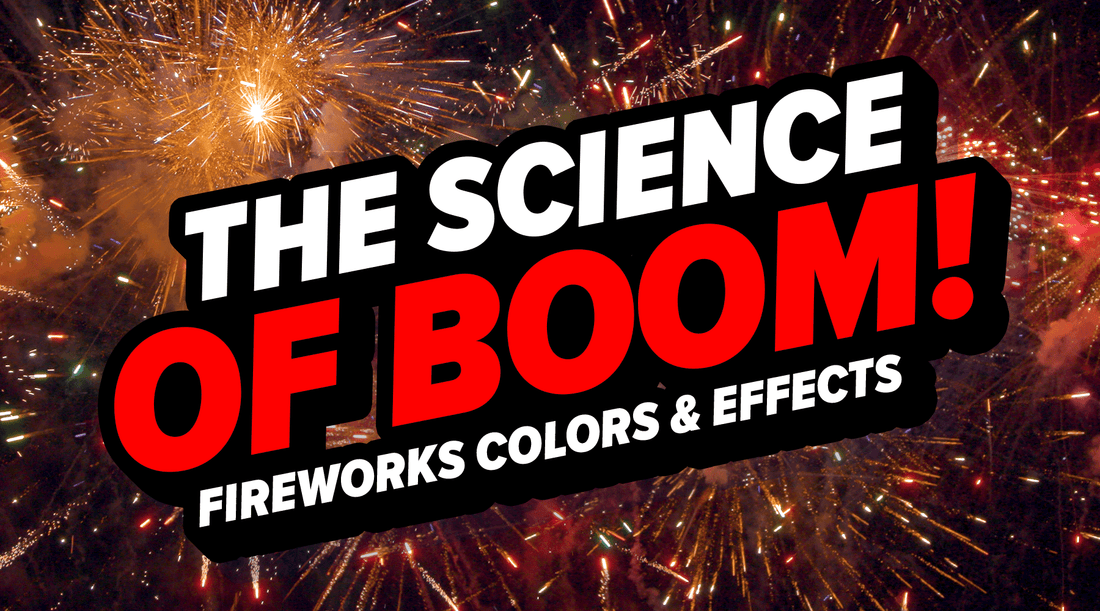We all know the truth - fireworks are f#@king amazing! You light a fuse and... BOOM amazing colors, loud bangs & beautiful effects appear right before your eyes! But did you ever stop to wonder how those colors are made or what the difference is between all those awesome effects? We've got you covered with the deets and we'll break it down like Bill Nye the Science Guy. But cooler, because... fireworks!
COLORS NEED CHEMS
At their core, the main thing that separates the reds from the blues, golds from silvers is the chemical used inside the firework. With the right combination of chemicals (or elements), the stars that burn when a firework is ignited will display some seriously awesome colors. Let's check out what's what:
- Yellow: This is mostly Sodium mixutres like Sodium Nitrate
- Green: To get those vivid greens, mixtures of Barium such as Barium Chloride or Barium Nitrate is used
- Red: Pretty much the most used color in fireworks! Strontium Carbonate or Strontium Nitrate is whipped up for red
- Blue: Copper, baby! When copper burns, you get a beautiful blue glow. Not only is copper used in fireworks, but it's also used in our Neon Fire™ Color-Changing Campfire Powder!
- Orange: Strong bones need Calcium, and so do orange fireworks! Calcium Chloride or Calcium Carbonate means you're gonna get some awesome orange colors.
By skillfully selecting the right combinations of chemicals, pyrotechnicias can make some totally amaze-balls color combinations that'll your viewers will love! When shopping online, you can filter our selection by the specific color or colors that you're looking for. Check 'em out here.
PEONIES? BROCADES? DAHLIAS?
There are like... a s#!t ton of different fireworks effects out there & more are created every year! Let's take a look at the differences between some of the most commonly seen fireworks effects:
- Peony: This is the most common firework effects and a feature in the Astro Catz™ XL® Aerial. It's a circular burst of colored stars, similar to a blooming flower
- Willow: Named after the willow tree, this effect features large stars followed by a comet-like tail that slowly fall downwards like branches of a weeping willow. Willows are a featured effect in these Chroma® 5" XL® Canister Shells.
- Crossette: This is a large star that explodes into smaller stars. In the fireworks we can buy, the large star usually explodes into 4 smaller stars. When you get into the professional stuff that uses more power, the smaller stars can continue to explode into even smaller stars!
- Palm: It's in the name! This effect displays an explosion of stars that streak out like the leaves of a tropical palm tree. If you're lookin' for palms, grab a Lunar Rainbow™ XL® Aerial!
- Brocade: A brocade effect is a large, slow-burning star that leaves a trail of sparks. The result is a spiderweb-like look in the sky. Brocades are usually gold & silver. Thick looking golden tails are usually Brocade tails too! You'll find this effect in most fireworks, but there are a lot in our Reloadable Shell Kits.
- Strobing and Glittering: Tiny shavings of metal like aluminum or iron, create the strobing/sparkling effect that lingers in the sky. Silver is the most popular color to accopmany this effect.
- Crackling Sounds: Special compounds called crackling stars produce the distinctive crackling and popping sounds we associate with fireworks
- Whistling and Screaming Noises: Air whistles and screaming fireworks use specially designed plastic tubes to create high-pitched whistling and screaming sounds. Check out Banshee™.
- Smoke and Fog Effects: Smoke-producing compounds, like titanium dioxide or zinc oxide, are used to create dense clouds of smoke in smoke tubes, smoke balls & daytime smoke aerials like Daytime Celebration™
- Looking for a specific effect or combinations of effects? Use our effect filter to see only the effect you want here.
APPRECIATE THE BOOM
Next time you find yourself light up some fireworks or enjoying the show from a safe distance, take a second to appreciate the intricate science and artistry that goes into each burst of color and every dazzling effect. The fireworks you're watching are hand-made by people dedicated to this art form. From the precise combinations of chemical compounds to the careful construction by Pyrotechnican, fireworks are a testament to creativity. So, the next time you witness the BOOM, remember the science behind the show. It's a reminder of our ability to transform the ordinary into the extraordinary, turning the night sky into a canvas of color.

